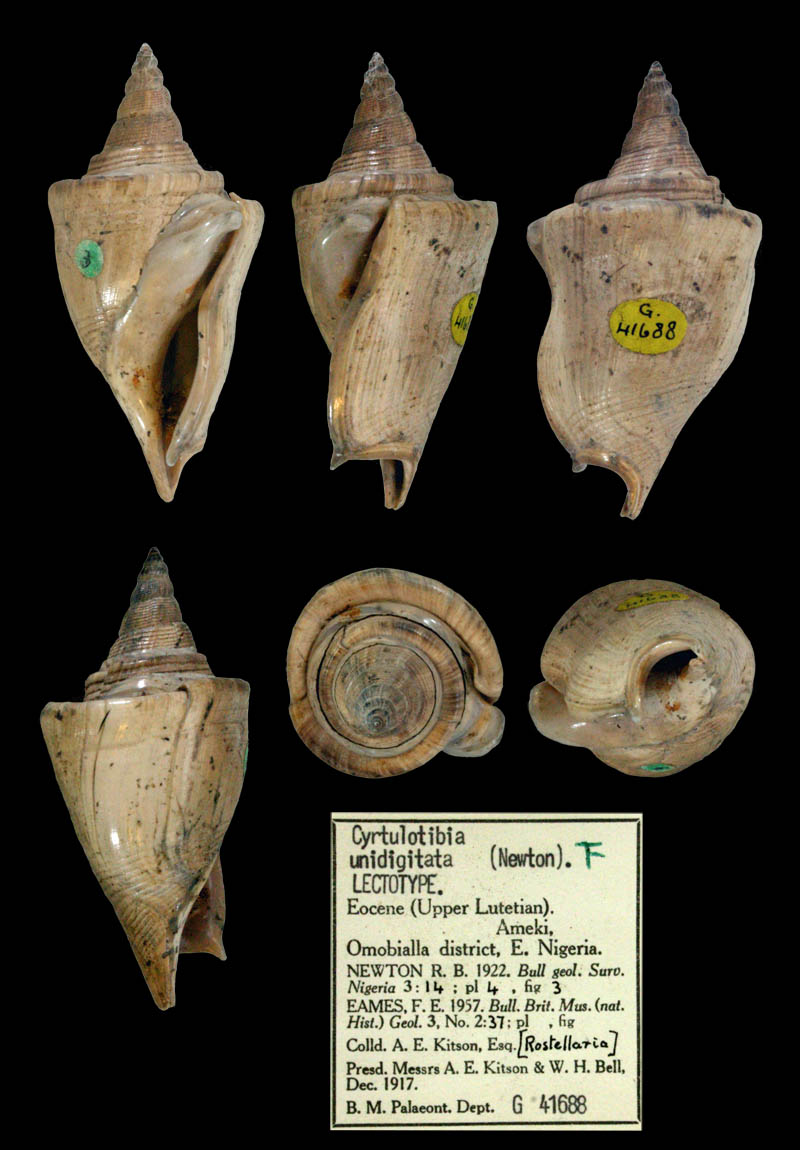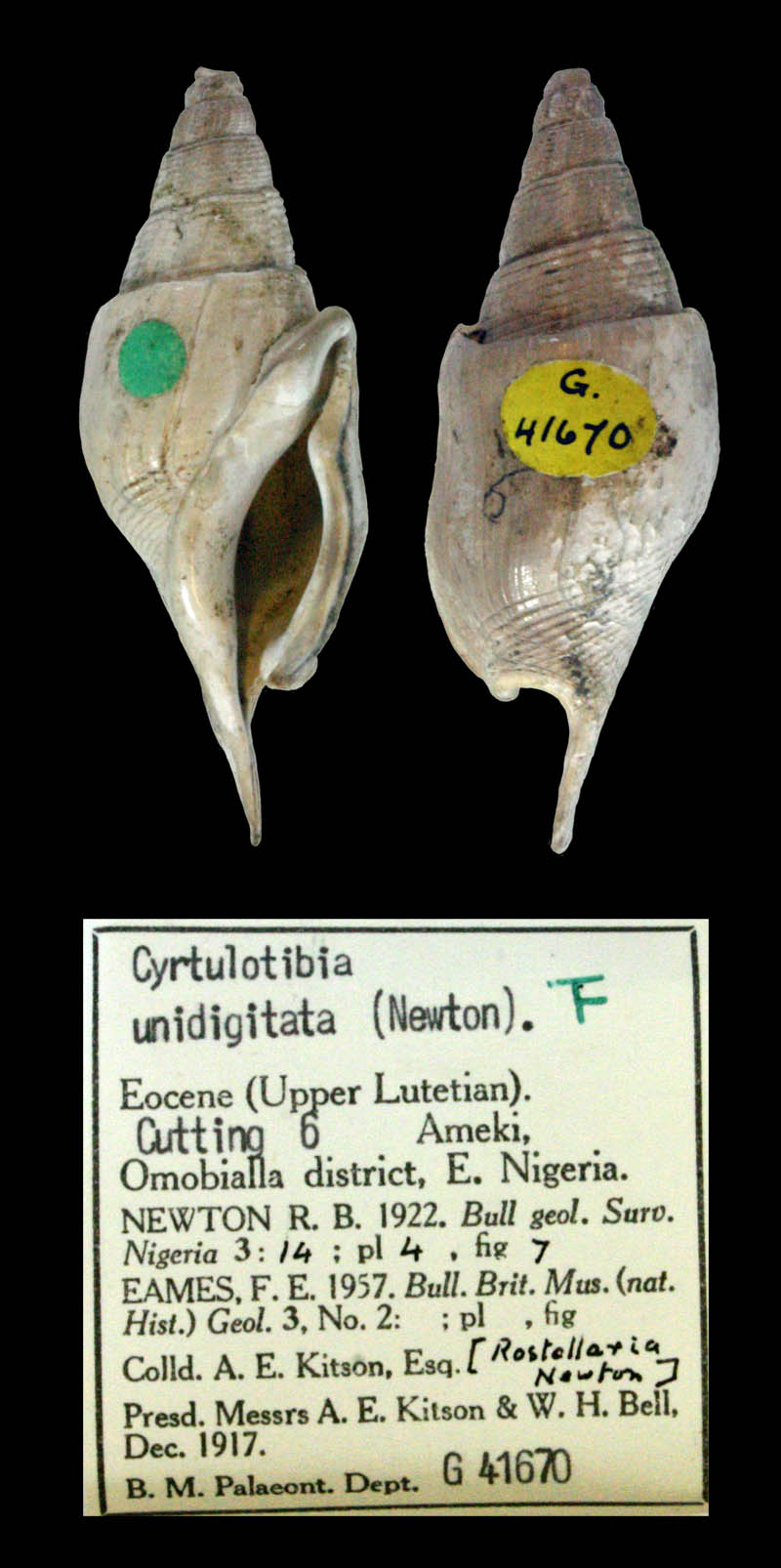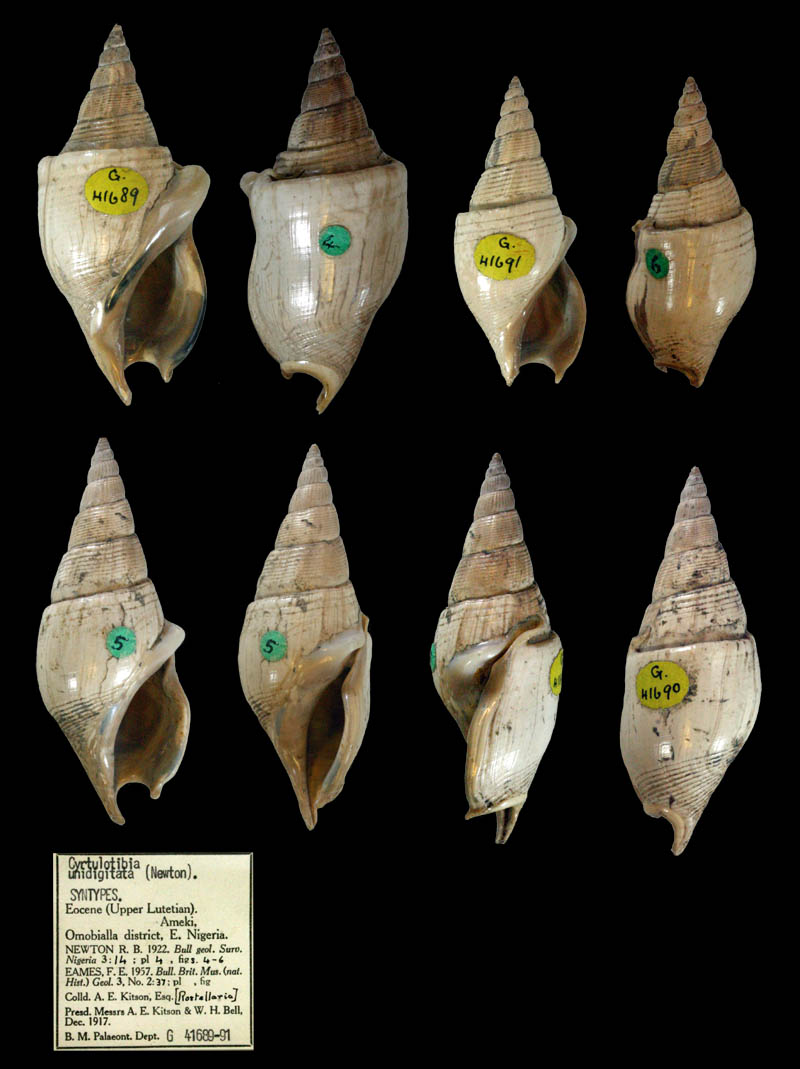|
edit SideBar
|
Species / Cyrtulotibia Unidigitata
Stromboidea
Original Description of Rostellaria unidigitata by Newton, 1922, p. 14:
- "Shell robust, pyramidial above, oblong below, depresso-convex; body-whorl excavated at suture, obtusely margined, compresso-convex, oblong, length exceeding that of the spire, canaliculated anteriorly and in rear; spire with seven or eight high and laterally depressed whorls, suture deep, nuclear whorls smooth and obtusely apexed; surface with strong spiral bands divided by longitudinally striated grooves, earlier whorls, excluding the nuclear whorls, furnished with numerous vertical placations, and obscure varices, body-whorl more or less smooth, finely and microscopically striated in both directions in nearly half its length, whilst the base is strongly and spirally ornamented; aperture obliquely elliptical, widely notched below and narrowly canaliculated at each end, the posterior canal is directed backward from the front along the sutural platform; labrum smooth within, border posteriorly excavated and outwardly curved below, thick, with wide reflective lip, which forms a single spinose digitations in front, afterwards surrounding the notch, and similarly the inner side of the narrow, curved, anterior canal; columella smooth, excavated, covered with a strong callosity which is elevated, thick and much enameled posteriorly where it forms the inner boundary of the canal, which thins out at the angle and extends along the sutural cavity of the body-whorl, besides forming part of the recurved posterior canal."
Locus typicus: Ameki, Omobialla District, Nigeria
Lectotype: R.B. Newton, 1922 pl. 4 fig. 3, designated by F.E. Eames, 1957, 3.
no. G.41688 (British Museum of Natural History)
Cyrtulotibia unidigitata (Newton, 1922); Lectotype; upper Lutetian, Eocene; Ameki, Omobialla District, Nigeria; Coll. BM(NH) no. G.41688; Copyright BM(NH)
Cyrtulotibia unidigitata (Newton, 1922); upper Lutetian, Eocene; Ameki, Omobialla District, Nigeria; Coll. BM(NH) no. G.41670; Copyright BM(NH)
Cyrtulotibia unidigitata (Newton, 1922); upper Lutetian, Eocene; Ameki, Omobialla District, Nigeria; Coll. BM(NH) no. G.416689-91; Copyright BM(NH)
Newton, 1922, p. 14:
- "REMARKS. This shell differs from R. bidigitata in the unidigitate character of the labrum, extensive body-whorl, the recurvation of the posterior canal, and the distribution of the callus over nearly half the basal surface of the penultimate whorl. In its single digitation and prominent notch it somewhat resembles Rimella, although differing considerably in form, while the posterior canal in that genus, instead of extending along the sutural region of the body-whorl, is perpendicularly attached to the spire and sometimes nearly reaching the summit, as in R. rimosa (Solander) from British and European Eocene deposits. The pyramidal spire fits well into the sunken, sutural cavity of the body-whorl, while the walls of the latter show a swollen character at the periphery, as well as a depression in its dorso-median region. The three whorls following the smooth nuclear volutions are prominently ornamented with numerous longitudinally, obliquely curved costae and strong spiral bands, whereas the next and penultimate whorls are restricted almost entirely to the spiral and vertically striated sculpture. Broad and distant varices are observable on the more sculptured portions of the spire, although much less obvious on the latter whorls. The sutural tabulation of the spire is often scarcely perceptible in younger forms of the species. Less developed and more delicately tested forms of this species are quite numerous, in which the sutural platform of the body-whorl is insignificant, the labrum thin and delicate not margined, being also without the digitation, while the callosity is only feebly indicated and not raised or thickened as in adult examples. The shell, admirably preserved, occurs in great profusion in Nigerian deposits, although only a few specimens show a complete anterior canal, and then only is this preserved in moderately young examples. Tubes of a small Serpula and other organisms are sometimes found adherent to the shell, chiefly in the region of the aperture. OCCURRENCE. Cuttings Nos. 1, 2, 5, 6, 10, 11, 12, 13, 15. COLLECTORS. Sir F. Lugard, Sir J. Eaglesome and Mr. Kitson."
References:
|



